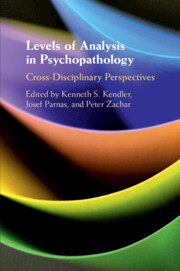Book contents
- Levels of Analysis in Psychopathology
- Advance Praise for Levels of Analysis in Psychopathology
- Levels of Analysis in Psychopathology
- Copyright page
- Contents
- Figures
- Tables
- Contributors
- Preface
- General Introduction
- Part I Neuroscience, Mechanisms, and RDoC
- Section 1
- Section 2
- Section 3
- 7 Introduction
- 8 Tackling Hard Problems: Neuroscience, Treatment, and Anxiety
- 9 Commentary on Daniel S. Pine
- Part II Phenomenology, Biological Psychology, and the Mind–Body Problem
- Part III Taxonomy, Integration, and Multiple Levels of Explanation
- Index
- References
9 - Commentary on Daniel S. Pine
from Section 3
Published online by Cambridge University Press: 02 April 2020
- Levels of Analysis in Psychopathology
- Advance Praise for Levels of Analysis in Psychopathology
- Levels of Analysis in Psychopathology
- Copyright page
- Contents
- Figures
- Tables
- Contributors
- Preface
- General Introduction
- Part I Neuroscience, Mechanisms, and RDoC
- Section 1
- Section 2
- Section 3
- 7 Introduction
- 8 Tackling Hard Problems: Neuroscience, Treatment, and Anxiety
- 9 Commentary on Daniel S. Pine
- Part II Phenomenology, Biological Psychology, and the Mind–Body Problem
- Part III Taxonomy, Integration, and Multiple Levels of Explanation
- Index
- References
Summary
This commentary summarizes and critiques the main themes in Dr. Pine’s chapter, including how to approach psychiatry from a clinical neuroscientific perspective. The “two-system model” of LeDoux and Pine is the backdrop for Pine’s approach, a model that is also outlined and critiqued in this author’s main chapter in this volume. The two-system model rationalizes and facilitates a synergistic bottom-up more primitive “attentional” and top-down attentional “appraisal” methodology to clinical treatments of threat assessment and anxiety, the basic findings of which are also presented in this chapter. The activity of appraisal, however, clearly involves consciousness, which as Dr. Pine notes, is only in the early stages of being understood scientifically and even philosophically, though Pine notes that cognitive-behavioral therapy does involve consciousness. Some suggestions are offered concerning possibilities as well as difficulties of working with animal models to advance this aspect of Pine’s clinical neuroscientific approach.
- Type
- Chapter
- Information
- Levels of Analysis in PsychopathologyCross-Disciplinary Perspectives, pp. 114 - 124Publisher: Cambridge University PressPrint publication year: 2020
References
- 1
- Cited by



